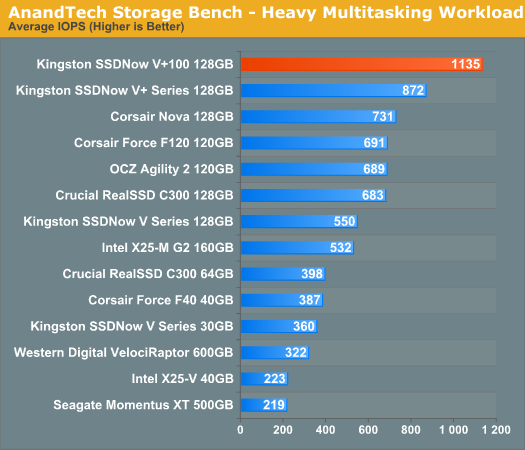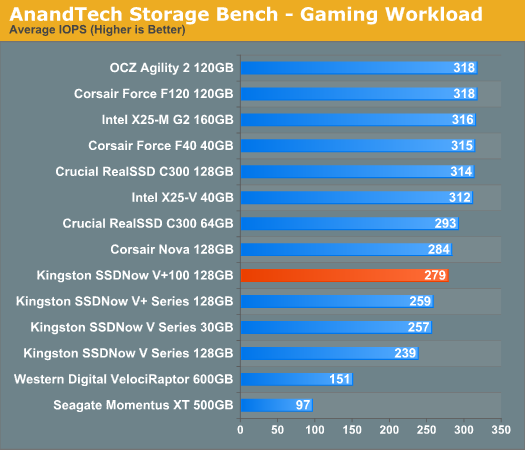Kingston SSDNow V+100 Review
by Anand Lal Shimpi on November 11, 2010 3:05 AM EST- Posted in
- Storage
- SSDs
- Kingston
- SSDNow V+100
AnandTech Storage Bench
To avoid any potential optimizations for industry standard benchmarks and to provide another example of real world performance we've assembled our own storage benchmarks that we've creatively named the AnandTech Storage Bench.
The first in our benchmark suite is a light/typical usage case. The Windows 7 system is loaded with Firefox, Office 2007 and Adobe Reader among other applications. With Firefox we browse web pages like Facebook, AnandTech, Digg and other sites. Outlook is also running and we use it to check emails, create and send a message with a PDF attachment. Adobe Reader is used to view some PDFs. Excel 2007 is used to create a spreadsheet, graphs and save the document. The same goes for Word 2007. We open and step through a presentation in PowerPoint 2007 received as an email attachment before saving it to the desktop. Finally we watch a bit of a Firefly episode in Windows Media Player 11.
There’s some level of multitasking going on here but it’s not unreasonable by any means. Generally the application tasks proceed linearly, with the exception of things like web browsing which may happen in between one of the other tasks.
The recording is played back on all of our drives here today. Remember that we’re isolating disk performance, all we’re doing is playing back every single disk access that happened in that ~5 minute period of usage. The light workload is composed of 37,501 reads and 20,268 writes. Over 30% of the IOs are 4KB, 11% are 16KB, 22% are 32KB and approximately 13% are 64KB in size. Less than 30% of the operations are absolutely sequential in nature. Average queue depth is 6.09 IOs.
The performance results are reported in average I/O Operations per Second (IOPS):

The higher capacity SandForce drives rule the roost here, but the C300, X25-M G2 and V+100 are not too far behind. Despite its age, Intel's X25-M G2 performs very well in our light usage test. The V+100 isn't far behind thanks to its 8.5% improvement over the original V+.
As far as small capacity drives go, the Corsair Force F40 and other similarly sized SandForce drives are the clear winners here. Crucial's 64GB RealSSD C300 is quicker than the X25-V, but no match for the 40GB SF drive.
If there’s a light usage case there’s bound to be a heavy one. In this test we have Microsoft Security Essentials running in the background with real time virus scanning enabled. We also perform a quick scan in the middle of the test. Firefox, Outlook, Excel, Word and Powerpoint are all used the same as they were in the light test. We add Photoshop CS4 to the mix, opening a bunch of 12MP images, editing them, then saving them as highly compressed JPGs for web publishing. Windows 7’s picture viewer is used to view a bunch of pictures on the hard drive. We use 7-zip to create and extract .7z archives. Downloading is also prominently featured in our heavy test; we download large files from the Internet during portions of the benchmark, as well as use uTorrent to grab a couple of torrents. Some of the applications in use are installed during the benchmark, Windows updates are also installed. Towards the end of the test we launch World of Warcraft, play for a few minutes, then delete the folder. This test also takes into account all of the disk accesses that happen while the OS is booting.
The benchmark is 22 minutes long and it consists of 128,895 read operations and 72,411 write operations. Roughly 44% of all IOs were sequential. Approximately 30% of all accesses were 4KB in size, 12% were 16KB in size, 14% were 32KB and 20% were 64KB. Average queue depth was 3.59.

This is another one of those SYSMark-like situations. The old Toshiba controller did just awesome in our heavy multitasking workload and the new update does even better. At 1135 IOPS, the V+100 is 55% faster than the Indilinx based Corsair Nova. Thanks to the incompressible nature of much of the data we're moving around in this benchmark the SandForce drives don't do so well. Although not pictured here, the 256GB C300 would be #2 - still outperformed by the V+100.
The gaming workload is made up of 75,206 read operations and only 4,592 write operations. Only 20% of the accesses are 4KB in size, nearly 40% are 64KB and 20% are 32KB. A whopping 69% of the IOs are sequential, meaning this is predominantly a sequential read benchmark. The average queue depth is 7.76 IOs.

The perplexing nature of the V+100 continues here. While it boasts great sequential read numbers, the smaller and somewhat random accesses drop the V+100 behind the SandForce and Crucial SSDs.










96 Comments
View All Comments
melgross - Thursday, November 11, 2010 - link
So, with all of this info presented, which drives would be best as a Photoshop scratch drive?Out of Box Experience - Tuesday, November 16, 2010 - link
Any modern platter based drive should be fine for a photoshop scratch driveKlober - Thursday, November 11, 2010 - link
This is my perspective from what I see throughout the review:The Corsair Force drives and the Crucial RealSSD drives are very close performance-wise in most of the comparisons; however, when price is included in the scenario the Corsair Force drives (60GB/120GB) win hands down.
The only true advantage the C300 has over the Force drives from what I can tell is in scenarios where the data is mostly uncompressible - I don't think this comes close to making up for the price disadvantage of the C300 drives since most likely users will have a large mechanical drive for their storage drive rather than opting to use their C300 for that purpose.
Taking into account the fact that you can get the Corsair Force 60GB SSD for $5 more than the 40GB at NewEgg, I would say that pretty much nullifies the cost/GB advantage of the C300 at the lower capacity - at that point you're looking at $2.109/GB for the C300 and $2.031/GB for the Force 60GB assuming it has 64GB NAND capacity (that's going by dividing the Force 120GB specs in half...if we instead use the specs from the Force 40GB that would put the Force 60GB at an amazing $1.805/GB for a low capacity SSD!).
If I were to buy an SSD tomorrow it would almost definitely be the Corsair Force 60GB for its fantastic (at least by SSD standards) cost/capacity at a low price point.
Anyway, that's my 2 cents!
Aikouka - Thursday, November 11, 2010 - link
Why are you assuming the Corsair drive magically has more space than it actually lists? If it's a 60GB drive, then you only get 60GB of usable space with some other amount set aside as a scratch area.Personally, I base my purchases more on random read than anything. Based on the prices, I'd most likely pick up the Crucial C300 64GB if I was looking for a new boot drive.
7Enigma - Thursday, November 11, 2010 - link
Just a simple request for a G2 80gig Intel drive for future reviews. I think many of us have one of these and know the 160gig drive is significantly faster in some tests (sequential write), but almost identical in others (random read I believe).DanNeely - Thursday, November 11, 2010 - link
Are there any tools available that will let you see how much of the write capacity of an SSD you've exhausted?Iketh - Thursday, November 11, 2010 - link
i own an intel 40gb and intel's trim software reports it... it's part of a drive's SMART data, so any SMART reading program should be able to tell you, but i could be mistakenMadMan007 - Thursday, November 11, 2010 - link
"Note that not all SandForce drives are created equal here. If a manufacturer doesn’t meet SandForce’s sales requirements, their drives are capped at a maximum of 50MB/s here. This is the case with the Patriot Inferno, although OCZ’s Agility 2 voluntarily enforces the limit."I understand there is the 'higher performance' Sandforce firmware (Vertex 2 vs Agility 2 for example) and the Agility 2-type firmware is the one that gets 'capped,' but what exactly do you mean by 'meet Sandforce's sales requirements'? Is this to say that the firmware the retail companies are licensed to use and able to ship is restricted based upon sales figres/order quantity, so that if say OCZ buys 100k SF controllers while Patriot only buys 10k, Patriot is limited in which firmware they are allowed to offer? If it's not that, what exactly do you mean? And most importantly how can we as end-users making a purchase determine this difference, is looking at IOPS all that's needed?
7Enigma - Thursday, November 11, 2010 - link
Anand,I didn't like the wording of the power consumption in terms of not being better at load than a mechanical hard drive. Just like your praise of Intel's hurry up and get idle (with turbo), all of these SSD's have an advantage in bursting and then getting idle.
I had mentioned it in a previous SSD article but what we really need is a moderated workload suite. Something like virus scan and total power draw during that time. While load voltages might be the same or higher for the SSD's, the total power consumption during that time will (should) be less. I think a virus scan is perfect on a normal system as it should take 10-20min and give a measureable difference between drives. Grab a laptop from one of your recent reviews (not an Atom or other super-slow mobile to prevent the SSD from waiting around), and measure the total power drawn over the scan.
This is less important in a desktop obviously but for the mobile crowd (whom sees the biggest benefit over the traditional laptop drives anyway) might just be one more criteria to help make a decision (or just show that it's the type of drive (mech/SSD) and not really differences between the SSD's themselves).
Glad to have a new SSD review though. I love reading these and am trying to justify upgrading from my 80gig Intel G2 drive that has been fantastic for the last year. The great thing about the SSD tech is that you can hand-me-down smaller capacity, slower drives and completely revolutionize an older system.
Thanks again.
JohnBooty - Thursday, November 11, 2010 - link
"Kingston ships the V+100 with a 3-year warranty and to Kingston's credit I haven't had any other drives die as a result of wearing out the NAND. Even if the V+100 has higher effective write amplification than the competition, your usage model will determine whether or not you bump into it."Anand,
Firstly, thank you for being the industry standard when it comes to articles about SSD. It's a favorite topic of mine and your articles have steered a lot of purchases in my personal and professional circles (and you haven't steered us wrong!)
My request...
One of the lingering questions about SSDs is how long they'll actually last in the real-world before the NAND is fried. When I see you mentioning that you've never actually fried any NAND, that seems like an opportunity for you to give it a shot and give the public some answers.
I'd love to see a "torture test" article where you run simulated workloads against SSDs 24/7 until they can't take any more writes, and report on the results.